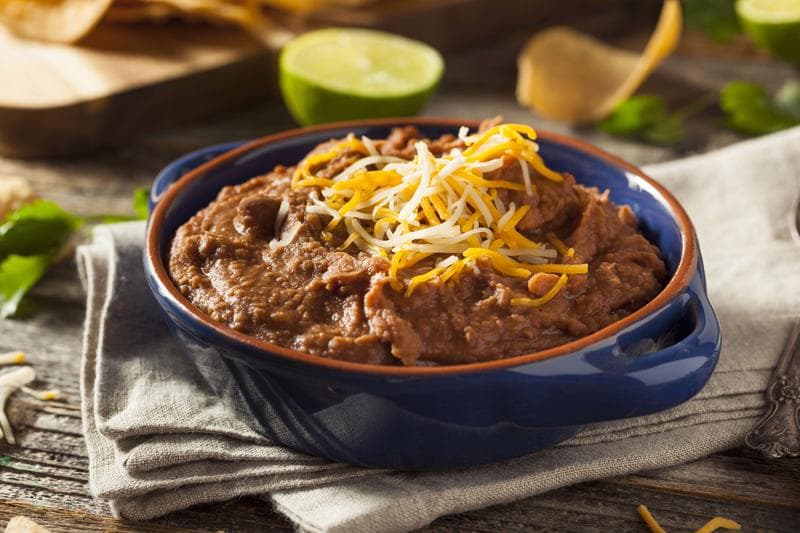Think refried beans fit seamlessly into a keto diet? Think again. While delicious and traditionally a staple in many dishes, refried beans contain a surprising amount of carbohydrates. These carbs can quickly exceed the daily limit for those meticulously tracking their intake on a ketogenic diet.
Historically, refried beans have been a vital part of various cuisines, celebrated for their rich flavor and versatility. However, with an average of 20 grams of net carbs per serving, they significantly surpass the recommended carb intake for keto followers. To maintain ketosis, exploring low-carb alternatives might be a more viable solution.

Understanding the Keto Diet
The keto diet is a low-carb, high-fat diet that has gained popularity for its potential health benefits. Its primary goal is to put your body into a state called ketosis. In ketosis, your body burns fat for energy instead of carbohydrates.
What Makes a Diet Ketogenic?
A ketogenic diet typically requires that you consume about 70% of your calories from fats, 20% from proteins, and only 10% from carbs. This drastic reduction in carbohydrates forces the body to use fat as its primary fuel source. It’s important to monitor your daily intake closely to maintain ketosis.
Transitioning to a ketogenic diet can be challenging, but many find the health benefits, such as improved mental clarity and weight loss, worth the effort. You’ll need to avoid high-carb foods like bread, pasta, and sugary snacks. Instead, focus on low-carb vegetables, meats, and healthy fats.
The Importance of Low Carb Intake
When you lower your carb intake, your body has to turn to stored fats for energy. This process produces ketones, which serve as an alternative energy source. Maintaining low carb intake is essential for staying in ketosis and reaping the benefits of the keto diet.
Tracking carbohydrates in your diet is crucial. Too many carbs can kick you out of ketosis, slowing down your progress. Use tools like food diaries and apps to keep an eye on your macronutrient ratios.
Benefits of the Keto Diet
Many people follow the keto diet for weight loss, but it has other benefits too. These include better blood sugar control and increased energy levels. Some studies even suggest it can have positive effects on certain neurological conditions.
It’s a diet that focuses on quality nutrition over empty calories. By emphasizing healthy fats and proteins, you can develop a sustainable and fulfilling eating pattern. However, consulting a healthcare professional before starting any new diet is always a wise decision.
The Nutritional Profile of Refried Beans
Refried beans are a common element in many dishes, but their nutritional profile is worth examining, especially for those on a keto diet. They are mostly made from pinto or black beans. These beans have various nutrients, but they also come with a high carb count.
Macronutrients in Refried Beans
Refried beans are relatively low in fats but high in carbohydrates. One cup can contain around 20 grams of net carbs, which is quite high for a keto diet. Protein content is moderate, making them a decent protein source but not ideal for those limiting carbs.
In addition, the carbohydrate content comes mainly from starches and sugars. This makes it hard for keto followers to incorporate refried beans into their diet. The high carb content can disrupt ketosis quickly.
Vitamins and Minerals
Refried beans are rich in essential vitamins and minerals. They contain significant amounts of iron, magnesium, and potassium. These nutrients are crucial for overall health.
Even though they are nutrient-dense, the high carb content often outweighs the benefits for keto dieters. It’s a trade-off that many find challenging to balance. Therefore, considering low-carb alternatives might be better.
High Fiber Content
Another significant aspect is their fiber content. Refried beans have substantial fiber, aiding in digestion and offering a feeling of fullness.
This can be beneficial for general health but does not fit well with the low-carb requirements of a ketogenic diet. High fiber intake can still disrupt ketosis, so it’s essential to weigh the pros and cons carefully.
Why Refried Beans are Not Keto-Friendly
Refried beans have a high carbohydrate content, making them unsuitable for the keto diet. Just one serving can exceed the daily carb limit needed to maintain ketosis. This quickly disrupts the body’s fat-burning process.
The keto diet allows very minimal carb intake, which usually ranges around 20-50 grams per day. Refried beans contain approximately 20 grams of net carbs per serving, which can make up most of your daily carb allowance. This leaves little room for other essential foods.
Additionally, refried beans often contain added sugars and fats during preparation. These additives can contribute to even higher carbohydrate and calorie counts. For anyone trying to stay in ketosis, this poses a significant challenge.
There are more keto-friendly alternatives that can be used in place of refried beans. Foods like cauliflower, zucchini, and certain low-carb legumes offer fewer carbs while still providing flavor. These options allow you to enjoy similar dishes without compromising your keto diet.
How to Monitor your Carb Intake on a Keto Diet
Monitoring your carb intake is crucial for maintaining ketosis on the keto diet. One effective way is using a food diary or an app to track your daily meals. These tools help you stay accountable and keep a record of your carb consumption.
Investing in a digital kitchen scale can also be very helpful. Weighing your food ensures you’re getting accurate measurements. This can prevent accidental overconsumption of carbs.
Reading food labels is another essential practice. Pay attention to the net carbs, which are total carbs minus fiber. This gives you a clearer picture of what you’re consuming.
Planning your meals in advance can help you control your carb intake better. Make a weekly menu that includes low-carb options. This reduces the temptation to eat high-carb foods.
When eating out, be cautious with sauces and dressings, as they often contain hidden carbs. Ask for these on the side so you can control how much you use. Opt for grilled, baked, or steamed food options instead of fried ones.
Finally, stay hydrated and incorporate electrolytes into your diet. Keeping a balanced diet helps minimize cravings and supports overall health. Simple habits like these make carb monitoring more manageable.
Alternative Low-Carb Substitutes for Refried Beans
Finding low-carb alternatives to refried beans can help maintain your keto diet while still enjoying flavorful dishes. One great option is mashed cauliflower. It has a similar texture but contains far fewer carbs.
Zucchini is another versatile vegetable that can be used in various ways. You can grill, steam, or mash it to create a tasty side dish. Its low carbohydrate content makes it an ideal choice for keto followers.
You might also consider using eggplant as a substitute. It can be baked, grilled, or mashed to mimic the consistency of refried beans. Eggplant offers a rich flavor and pairs well with many spices.
Avocado is a nutrient-dense option that’s low in carbs. You can mash it with some spices to create a creamy and satisfying side dish. Plus, it’s rich in healthy fats that align well with keto principles.
Another excellent alternative is shredded cabbage. Cook it with your preferred seasonings, and it can serve as a crunchy, low-carb replacement. This allows you to add variety without exceeding your carb limits.
For those who miss the bean flavor, consider trying black soybeans. They are much lower in carbs compared to traditional beans and can be seasoned similarly. This option provides a close taste match without the high carb load.
Other Factors to Consider when Choosing Keto-Friendly Foods
When following a keto diet, it’s essential to consider more than just carb content. The quality of the fat you’re consuming is crucial. Opt for healthy fats like avocados, olive oil, and nuts.
Protein intake should also be balanced. Too much protein can convert to glucose, kicking you out of ketosis. Aim for moderate protein sources such as lean meats and fish.
Micronutrients play a vital role in a well-rounded keto diet. Ensure you’re getting enough vitamins and minerals by incorporating a variety of low-carb vegetables. These contribute to overall health and help maintain energy levels.
Always check for hidden ingredients in processed foods. Many contain sugars and preservatives that can quickly add up in your carb count. Reading labels diligently can help you avoid these pitfalls.
Hydration is another key factor. Drinking plenty of water helps with digestion and keeps you feeling full. Incorporating electrolytes like sodium, potassium, and magnesium is also beneficial.
Lastly, consider how satisfying the foods are. High satiety foods help you stay full longer and reduce cravings. This makes it easier to stick to your diet and meet your nutritional goals.
Key Takeaways
- Refried beans are high in carbohydrates.
- One serving has about 20 grams of net carbs.
- This high carb content disrupts ketosis.
- Keto diets have strict low-carb limits.
- Consider low-carb alternatives to stay keto-friendly.

Frequently Asked Questions
If you’re navigating a keto diet, understanding which foods fit can be tricky. Here are some common questions about how refried beans and other foods relate to keto.
1. What makes a food keto-friendly?
A food is considered keto-friendly if it has low carbohydrates, moderate protein, and high fats. The goal is to maintain ketosis by keeping daily carb intake between 20-50 grams.
Keto-friendly foods include avocados, lean meats, and non-starchy vegetables. These foods provide the necessary nutrients while keeping your carb count low.
2. Are black beans better for a keto diet than refried beans?
Both black and refried beans are high in carbs and not ideal for keto diets. Black beans contain around 24 grams of net carbs per cup.
This amount also exceeds the typical daily carb limit for maintaining ketosis. Therefore, it’s best to find lower-carb alternatives if you’re on a ketogenic diet.
3. Can you eat any type of beans on a ketogenic diet?
Most beans are too high in carbohydrates to be considered keto-friendly. However, some exceptions exist like black soybeans, which have fewer carbs.
You should always check the nutritional information before including them in your meal plan. It’s crucial to stay within your daily carb limits to maintain ketosis.
4. What are good low-carb substitutes for beans on a keto diet?
Mash cauliflower can serve as an excellent substitute due to its similar texture but lower carbs. Other alternatives include zucchini, eggplant, and avocado.
You can prepare these vegetables in various ways to replicate your favorite bean dishes without compromising your keto lifestyle.
5. How do I know if I’m kicked out of ketosis by eating high-carb foods?
The easiest way to test this is by using ketone strips or meters that measure ketone levels in your blood or urine. Symptoms like increased hunger or fatigue can also indicate you’ve been kicked out of ketosis.
If this happens, you may need to recalibrate your diet by reducing your carb intake and focusing on high-fat foods again.

Conclusion
Incorporating the right foods into your keto diet is crucial for maintaining ketosis and achieving your health goals. While refried beans might not fit the keto criteria due to their high carb content, there are plenty of low-carb alternatives to explore. Paying attention to macros and using tools like food diaries can help you stay on track.
Always read food labels and make informed choices to support your dietary needs. By focusing on nutrient-dense, low-carb foods, you can enjoy a varied and satisfying keto diet. With careful planning and the right substitutes, staying in ketosis becomes much more manageable.
